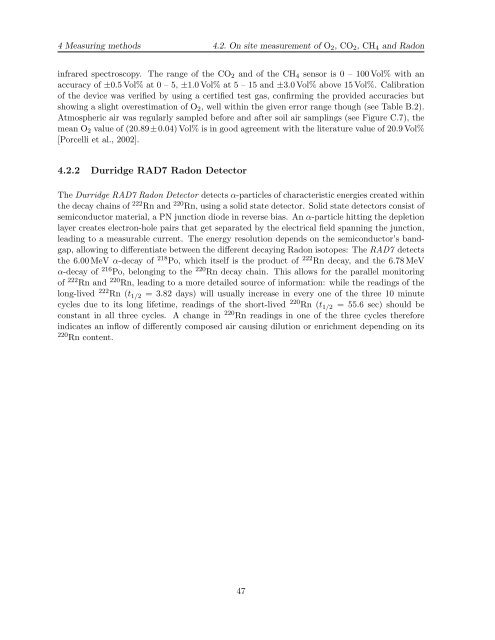Diploma thesis in Physics submitted by Florian Freundt born in ...
Diploma thesis in Physics submitted by Florian Freundt born in ...
Diploma thesis in Physics submitted by Florian Freundt born in ...
You also want an ePaper? Increase the reach of your titles
YUMPU automatically turns print PDFs into web optimized ePapers that Google loves.
4 Measur<strong>in</strong>g methods 4.2. On site measurement of O2, CO2, CH4 and Radon<br />
<strong>in</strong>frared spectroscopy. The range of the CO2 and of the CH4 sensor is 0 – 100 Vol% with an<br />
accuracy of ±0.5 Vol% at 0 – 5, ±1.0 Vol% at 5 – 15 and ±3.0 Vol% above 15 Vol%. Calibration<br />
of the device was verified <strong>by</strong> us<strong>in</strong>g a certified test gas, confirm<strong>in</strong>g the provided accuracies but<br />
show<strong>in</strong>g a slight overestimation of O2, well with<strong>in</strong> the given error range though (see Table B.2).<br />
Atmospheric air was regularly sampled before and after soil air sampl<strong>in</strong>gs (see Figure C.7), the<br />
mean O2 value of (20.89±0.04) Vol% is <strong>in</strong> good agreement with the literature value of 20.9 Vol%<br />
[Porcelli et al., 2002].<br />
4.2.2 Durridge RAD7 Radon Detector<br />
The Durridge RAD7 Radon Detector detects α-particles of characteristic energies created with<strong>in</strong><br />
the decay cha<strong>in</strong>s of 222 Rn and 220 Rn, us<strong>in</strong>g a solid state detector. Solid state detectors consist of<br />
semiconductor material, a PN junction diode <strong>in</strong> reverse bias. An α-particle hitt<strong>in</strong>g the depletion<br />
layer creates electron-hole pairs that get separated <strong>by</strong> the electrical field spann<strong>in</strong>g the junction,<br />
lead<strong>in</strong>g to a measurable current. The energy resolution depends on the semiconductor’s bandgap,<br />
allow<strong>in</strong>g to differentiate between the different decay<strong>in</strong>g Radon isotopes: The RAD7 detects<br />
the 6.00 MeV α-decay of 218 Po, which itself is the product of 222 Rn decay, and the 6.78 MeV<br />
α-decay of 216 Po, belong<strong>in</strong>g to the 220 Rn decay cha<strong>in</strong>. This allows for the parallel monitor<strong>in</strong>g<br />
of 222 Rn and 220 Rn, lead<strong>in</strong>g to a more detailed source of <strong>in</strong>formation: while the read<strong>in</strong>gs of the<br />
long-lived 222 Rn (t 1/2 = 3.82 days) will usually <strong>in</strong>crease <strong>in</strong> every one of the three 10 m<strong>in</strong>ute<br />
cycles due to its long lifetime, read<strong>in</strong>gs of the short-lived 220 Rn (t 1/2 = 55.6 sec) should be<br />
constant <strong>in</strong> all three cycles. A change <strong>in</strong> 220 Rn read<strong>in</strong>gs <strong>in</strong> one of the three cycles therefore<br />
<strong>in</strong>dicates an <strong>in</strong>flow of differently composed air caus<strong>in</strong>g dilution or enrichment depend<strong>in</strong>g on its<br />
220 Rn content.<br />
47
















